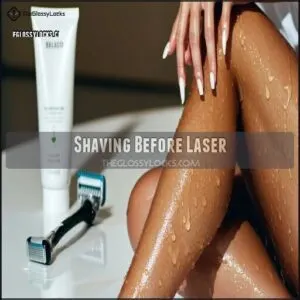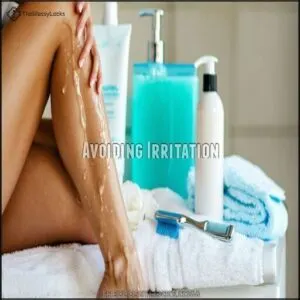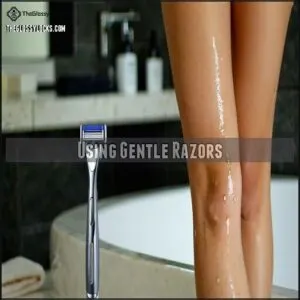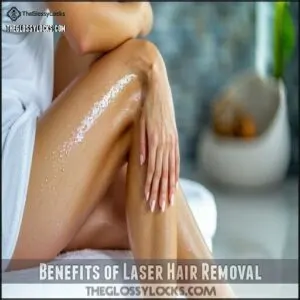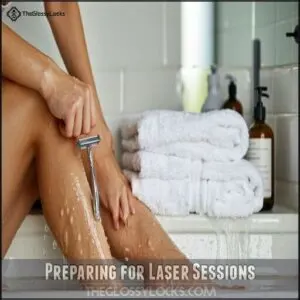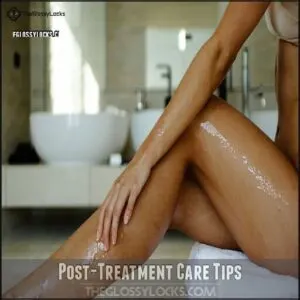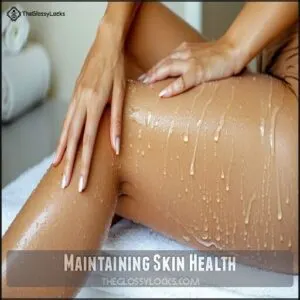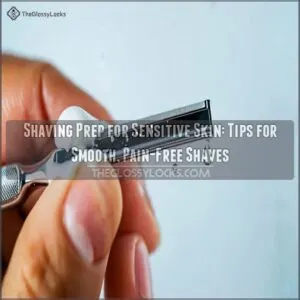This site is supported by our readers. We may earn a commission, at no cost to you, if you purchase through links.
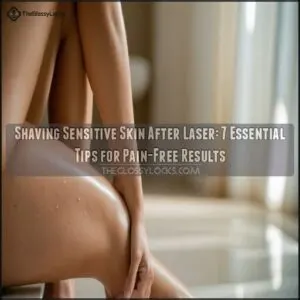 Shaving sensitive skin after laser can be tricky, but it’s doable with care.
Shaving sensitive skin after laser can be tricky, but it’s doable with care.
Wait at least 48 hours post-treatment to let your skin heal. Use a clean, sharp razor to avoid irritation or infections—your skin’s already been through a lot, so it deserves some TLC.
Shave gently, using a fragrance-free shaving cream to keep things smooth and irritation-free. Avoid pressing too hard on the skin, and skip shaving over any redness, bumps, or sensitive spots.
Moisturize afterward with a soothing, non-comedogenic lotion. Taking these steps can make all the difference in keeping your skin happy while you enjoy laser-smooth results.
Table Of Contents
- Key Takeaways
- Shaving Before Laser
- Shaving After Laser
- Sensitive Skin Considerations
- Post-Treatment Care Tips
- Maintaining Skin Health
- Frequently Asked Questions (FAQs)
- How soon after laser can I shave?
- Why is it so hard to shave after laser?
- Does shaving affect shedding after laser?
- How long is your skin sensitive after laser hair removal?
- How to manage itching after laser hair removal?
- What to do if blisters appear post laser treatment?
- How to treat dryness after shaving sensitive skin?
- Are there specific diets to improve post-laser recovery?
- Conclusion
Key Takeaways
- Wait at least 48 hours after laser treatment before shaving to let your skin heal and avoid irritation.
- Use a clean, sharp razor with fragrance-free shaving cream to prevent infections and reduce sensitivity.
- Shave gently, following the hair growth direction, and avoid shaving over redness or bumps.
- Moisturize afterward with a soothing, non-comedogenic lotion to keep your skin calm and hydrated.
Shaving Before Laser
You’ll need to shave 12 to 24 hours before your laser hair removal session to allow the laser to directly target hair follicles beneath the skin.
Using a clean, sharp razor helps prevent irritation and guarantees the best results while avoiding excessive stubble that can interfere with the treatment.
A clean, sharp razor is your path to irritation-free skin and optimal laser hair removal results every time.
Pre-Treatment Guidelines
The countdown to your laser hair removal starts with proper preparation.
Before your session, shave 12-24 hours prior using a clean, new razor. This timing allows specialists direct access to hair follicles without excessive stubble that could cause heat buildup.
Avoid sun exposure for 3 weeks before treatment, and skip moisturizers, waxing, or plucking. For sensitive skin, these pretreatment preparations prevent irritation while maximizing your laser treatment effectiveness.
Proper preparation includes gentle exfoliation techniques to prevent ingrown hairs, which is crucial for sensitive skin and overall treatment success.
Importance of Shaving
Now that you know the guidelines, let’s talk about why shaving before your laser treatment matters so much.
Shaving provides direct access to hair follicles beneath the skin, allowing the laser to target them effectively.
Without proper shaving, the laser energy gets wasted on surface hair instead of reaching the follicles. Think of it as clearing a path for the treatment to work its magic on your sensitive skin.
Clearing a smooth path lets the laser target follicles directly, maximizing results and enhancing the magic for your sensitive skin.
Avoiding Excessive Stubble
Excessive stubble creates a significant obstacle before laser hair removal.
When hair is too long, the laser energy can scatter at the skin’s surface, affecting pigment and causing potential burns.
You’ll want to avoid both shaving creams and electric razors, as they can remove protective skin layers.
For ideal results, complete your night-before shave with a manual razor, leaving just enough visibility for the technician to target the follicles.
Using Clean Razors
Beyond controlling stubble length, your razor hygiene directly impacts your skin’s reaction to laser treatment. Always use clean razors when shaving before laser hair removal to minimize bacteria on your skin.
- Replace blades regularly to prevent razor burn and irritation
- Rinse razors thoroughly after each use to remove hair and product buildup
- Store razors in dry areas to prevent bacterial growth
Clean tools help prevent skin infections and ingrown hairs, especially on sensitive skin.
Shaving After Laser
You’ll need to wait 24-48 hours after your laser treatment before picking up that razor again.
Your skin needs time to recover from the treatment, preventing irritation and allowing those treated hairs to begin falling out naturally.
Waiting Period
The vital waiting period after laser hair removal determines your skin’s recovery success.
You’ll need to be patient before reaching for that razor again.
| Recovery Phase | Waiting Time | Signs to Watch |
|---|---|---|
| Initial | 48-72 hours | Redness, swelling |
| Intermediate | 3-4 days | Mild sensitivity |
| Extended | 7-14 days | Hair shedding |
| Complete | 2+ weeks | Full healing |
Don’t rush this process – your skin needs time to heal properly after treatment.
Shaving too soon can disrupt the hair shedding phase.
Allowing Skin to Heal
Your skin needs time to recover after laser hair removal.
Give treated areas at least 48-72 hours of rest before reaching for your razor.
During this post-laser recovery period, your skin is working to reduce redness and swelling.
The healing timeline varies for everyone, but patience pays off.
If you still notice irritation after three days, wait longer.
Your skin will thank you for this extra healing time.
Avoiding Irritation
Now that your skin is healing, preventing irritation becomes your next priority.
When shaving after laser, always go with the grain of hair growth first. This simple technique reduces friction that can aggravate sensitive skin.
Wait until redness subsides completely before attempting to shave. Using a quality shaving cream or gel can also help, as they provide skin lubrication.
Applying a cool gel before shaving creates a protective barrier, minimizing skin sensitivity and preventing irritation after your laser treatment. This helps in achieving a smooth shave.
Using Gentle Razors
After laser hair removal, a gentle razor can prevent razor burn and irritation.
Look for razors made for sensitive skin.
Follow these tips:
- Choose the best razors for sensitive skin with flexible blades.
- Shave using a light touch to avoid ingrown hairs.
- Angle blades gently for a smooth shave.
- Clean razors regularly.
- Replace dull blades often for safe shaving.
Consider using specialized shaving products for best results.
Sensitive Skin Considerations
When shaving sensitive skin after laser treatments, it’s important to take extra care to avoid irritation.
Understanding how your skin reacts and using gentle techniques can help keep it smooth and comfortable.
Challenges of Hair Removal
Hair removal for sensitive skin isn’t exactly a walk in the park.
Shaving can cause skin irritation, while waxing may leave behind redness and discomfort. Depilatory creams? They often trigger allergic reactions.
Here’s a quick breakdown:
| Method | Common Issue | Level of Discomfort |
|---|---|---|
| Shaving | Ingrown hairs | Moderate |
| Waxing | Redness and swelling | High |
| Creams | Allergic reactions | Varies |
Understanding these helps tailor laser hair removal aftercare, which is crucial for sensitive skin to avoid skin irritation.
Benefits of Laser Hair Removal
Tired of constant razor bumps and irritation?
Laser hair removal offers permanent reduction of hair while improving skin health.
It’s a great alternative to painful hair removal methods like waxing.
With reduced ingrowns and long-term savings, laser treatment boosts your confidence by leaving skin smoother.
Say goodbye to frequent shaving and hello to a gentler, low-maintenance solution.
Preparing for Laser Sessions
A successful laser treatment depends on solid preparation. Stay hydrated to keep your skin healthy, and avoid sun exposure for three weeks before starting.
Talk with your technician about sensitive skin concerns during your consultation—this includes scheduling a patch test.
Skip waxing or plucking before laser sessions; stick with shaving instead. For sensitive skin, consider using fragrance-free products to minimize irritation.
Follow the guidelines to guarantee smoother results and ensure you have a good understanding of the process for sensitive skin.
Communicating Skin Concerns
When discussing sensitive skin with your technician, honesty is key for smooth laser hair removal.
Mention any medications you’re taking since they can affect skin reactions.
Request patch testing to check for irritation and guarantee treatment customization.
Set realistic expectations with the dermatologist.
Open communication prevents issues like skin irritation and makes shaving after laser a worry-free process.
Post-Treatment Care Tips
After laser treatment, taking care of your skin is critical to prevent irritation and promote healing.
Simple steps like moisturizing, using sunscreen, and avoiding harsh products can make all the difference, as they are essential for proper healing.
Moisturizing and Exfoliating
After laser hair removal, your skin needs extra care.
Moisturizing and exfoliating at the right time can help.
- Hydrate with fragrance-free lotion 48 hours after treatment to soothe irritation.
- Wait a week before gently exfoliating to prevent clogged follicles.
- Stick to soothing ingredients like aloe vera to avoid further sensitivity.
Consider using fragrance-free aloe products for superior results.
Gentle techniques guarantee smooth post-laser shaving.
Applying Sunscreen
After laser hair removal, sunscreen application is a must. Choose broad-spectrum protection with SPF 30+ to shield your sensitive skin from harmful UV exposure.
Reapply every two hours if you’re outdoors for lasting UV protection.
Sun protection reduces risks of skin cancer and pigmentation.
For maximum defense, consider products with high SPF.
Avoid direct sunlight, as laser-treated skin reacts strongly to UV rays, needing extra care.
Avoiding Harsh Products
Shield your sensitive skin from irritation by steering clear of harsh products after laser treatments.
Opt for:
- Gentle cleansers and hypoallergenic options to clean without stripping oils.
- Fragrance-free lotions with natural ingredients for soothing hydration.
- Mild exfoliants to support natural healing.
Sticking to sensitive skin care helps you stay comfortable, especially when shaving after laser treatment.
Avoid anything overly harsh or drying, and opt for gentle cleansers and hypoallergenic options to maintain skin comfort.
Using Cold Compresses
After shaving, your skin might feel sensitive and irritated.
Applying cold compresses is a quick way to reduce inflammation and minimize swelling. They provide pain relief while soothing irritation from laser treatment aftercare.
Wrap ice in a soft cloth and gently press it onto your skin. This compress application helps with skin irritation relief, keeping your post-laser care effective and comfortable.
Maintaining Skin Health
Taking care of your skin after laser treatment is essential to keep it healthy and irritation-free. A gentle routine with the right products helps soothe sensitivity and prevents long-term issues.
Gentle Skincare Routine
Keep sensitive skin happy after laser hair removal by sticking to a gentle skincare routine.
Use fragrance-free products to avoid irritation, and apply a cold compress if redness flares up.
Gentle exfoliation, done after a few days, keeps skin smooth.
Maintain hydration with light moisturizers and prioritize sunscreen importance daily.
These steps make shaving after laser less stressful.
Avoiding Direct Sun Exposure
Sensitive skin after treatment needs extra care under the sun.
UV ray sensitivity increases, so avoid direct sun exposure for a month to prevent pigmentation risks and protect treatment efficacy.
Use high-SPF broad-spectrum sunscreen daily, even on cloudy days, and grab protective clothing like wide-brimmed hats.
Sunscreen application isn’t optional—it’s your shield against UV rays that harm healing skin.
Exfoliating Regularly
After avoiding sun exposure, focus on exfoliation to maintain smooth, post-laser skin.
Gentle exfoliation helps shed dead cells and prevents clogged follicles. Stick to 2-3 times a week to avoid overdoing it.
- Use fragrance-free scrubs or soft brushes.
- Try circular motions for even exfoliation.
- Pick products with natural ingredients like oatmeal or rice powder for sensitive skin, which aids in smooth skin.
Using Soothing Products
A little aloe vera or calendula cream can work wonders for soothing skin after shaving.
Cooling gels and tea tree products also help calm sensitive skin while reducing irritation.
Look for skin care products that support lipid replenishment to keep your skin hydrated.
Treat your skin gently post-laser shaving, and skip anything harsh that might cause irritation.
Many people find that fragrance-free creams help calm redness.
Frequently Asked Questions (FAQs)
How soon after laser can I shave?
Wondering when it’s safe to shave after laser treatment?
Wait at least 48 hours.
Your skin needs time to heal, and shaving too soon can lead to irritation.
Always use a clean, sharp razor.
Why is it so hard to shave after laser?
It’s tough to shave after laser because your skin stays sensitive for a while.
Shaving too soon can irritate the treated area, causing redness or discomfort.
Waiting a few days helps your skin heal completely.
Does shaving affect shedding after laser?
Think of shedding like nature’s way of letting go.
Shaving doesn’t stop shedding but trims surface hair.
Let the follicles work their magic underneath, and shave gently to avoid irritation or slowing down the process.
How long is your skin sensitive after laser hair removal?
Your skin stays sensitive for about 1-3 days after laser hair removal, though this varies.
Redness or swelling can last longer.
Always wait until your skin feels normal before using harsh products or shaving.
How to manage itching after laser hair removal?
Think of your skin like a sunburned peach—handle it gently.
Reduce itching by applying a cold compress, fragrance-free moisturizer, or aloe vera.
Avoid hot showers, tight clothes, and scratchy fabrics to let your skin recover gracefully.
What to do if blisters appear post laser treatment?
If blisters appear after laser treatment, keep the area clean and dry.
Avoid picking or popping them to prevent infection.
Use a gentle, fragrance-free moisturizer, and consult your provider for proper care or medication recommendations.
How to treat dryness after shaving sensitive skin?
Moisturize immediately after shaving with a fragrance-free lotion to prevent dryness.
Use aloe vera or a cream with ceramides for extra hydration.
Avoid hot showers and harsh products, keeping skin calm and irritation-free, using methods like applying aloe vera.
Are there specific diets to improve post-laser recovery?
You might worry diet won’t help much, but eating antioxidant-rich foods like berries, leafy greens, and nuts can boost healing.
Stay hydrated, avoid processed foods, and focus on Vitamin C and protein for faster recovery.
Conclusion
Shaving sensitive skin after laser doesn’t have to be intimidating if you follow these steps.
Let your skin rest for 48 hours before picking up a razor, and always use a clean, sharp blade with fragrance-free shaving cream.
Be gentle—avoid pressing too hard or shaving over irritated areas.
Post-shave, moisturize with a soothing, non-comedogenic lotion to keep your skin calm and hydrated.
With proper care, you’ll maintain laser-smooth results while keeping your sensitive skin happy.
- https://www.lanaskyn.com/en/post/how-long-not-to-shave-after-laser
- https://www.harleyskinandlaser.co.uk/uncategorized/how-to-shave-correctly/
- https://www.healthline.com/health/beauty-skincare/laser-hair-removal-aftercare
- https://knottstdermatology.com/laser-hair-removal-and-sensitive-skin-7-things-you-need-to-know/
- https://www.glowmedspa.com/do-you-need-to-shave-after-laser-hair-removal/

